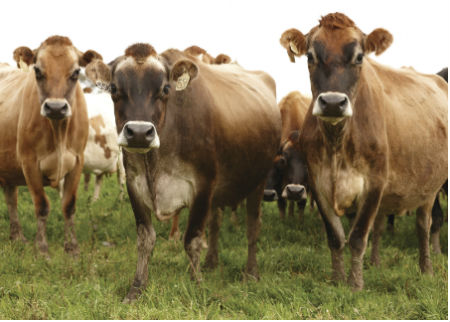Master the Art of Food Preparation With Grass Fed Meat
In the world of cooking competence, mastering the art of food preparation with grass-fed meat holds a prominent placement. From the tender texture to the durable flavor account, grass-fed meat presents a canvas for culinary creative thinking.
Advantages of Grass-Fed Meat

When choosing grass-fed meat, consumers can take advantage of its greater levels of omega-3 fats and anti-oxidants contrasted to conventionally raised meat. Constance Cattle. Omega-3 fatty acids are vital nutrients that sustain brain health and wellness, reduce inflammation, and promote heart wellness. Grass-fed meat is recognized to have up to 5 times more omega-3 fats than grain-fed meat, making it a healthier choice for those looking to enhance their consumption of these valuable fats
Along with omega-3 fatty acids, grass-fed meat is additionally richer in anti-oxidants such as vitamins E and C, in addition to beta-carotene. Anti-oxidants play a critical role in safeguarding cells from damage triggered by totally free radicals, which can add to numerous persistent diseases and accelerate aging. By choosing grass-fed meat, customers can not only delight in a more tasty and nutrient-dense protein resource however also support their total health and wellness and health.
Integrating grass-fed meat right into your diet plan can be a basic yet reliable way to improve your nutritional consumption and enjoy the benefits of omega-3 fatty acids and antioxidants that are naturally bountiful in this kind of meat.
Finest Food Preparation Techniques
Using suitable food preparation approaches is necessary to maintain the nutrient profile and boost the flavor of grass-fed meat. When cooking grass-fed meat, it is essential to keep in mind that it is leaner than traditionally raised meat, making it extra vulnerable to drying if overcooked. To guarantee a juicy and flavorful outcome, consider cooking grass-fed meat at slightly reduced temperature levels than you would with grain-fed meat.
Barbecuing is a popular approach for food preparation grass-fed meat as it allows excess fat to drip away, stopping flare-ups that can create charring. When barbecuing grass-fed meat, use medium warm and maintain a close eye on it to avoid overcooking. One more excellent food preparation technique for grass-fed meat is pan-searing. This technique aids secure in the juices and produce a tasty crust on the meat.
Sluggish cooking strategies such as braising or cooking are also outstanding alternatives for harder cuts of grass-fed meat, as they help damage down the muscular tissue fibers and tenderize the meat. Whichever cooking technique you select, bear in mind to let grass-fed meat remainder after preparing to permit the juices to rearrange, making certain a damp and tender last meal.
Flavor Pairings and Seasonings
To improve the all-natural tastes of grass-fed meat, calculated flavor pairings and spices play an important role in boosting the overall dining experience. Grass-fed meat has a rich, unique preference that can be complemented and improved by meticulously selected active ingredients. When it involves taste pairings, natural herbs like thyme, rosemary, and oregano work remarkably well with grass-fed beef, lamb, or bison. These natural herbs include deepness and earthiness to the meat, improving its natural flavors without overpowering them.
Along with herbs, spices such as black pepper, garlic, and smoked paprika can further elevate the taste account of grass-fed meat recipes. These flavors supply an equilibrium of warmth, sweetness, and smokiness that can enhance the total dining experience. When seasoning grass-fed meat, it is essential to use top notch salt, like sea salt or Himalayan salt, to draw out the meat's tastes without adding unneeded chemicals or additives.
Storage and Handling Tips
Correct storage and managing practices are crucial for maintaining the quality and freshness of grass-fed meat. When keeping grass-fed meat, it is vital to maintain it cooled at temperature levels below 40 ° F(4 ° C) to stop microbial growth and perishing. To extend the meat's service life, take into consideration covering it tightly in parchment paper or butcher paper before putting it in an impermeable container or secured plastic bag - Constance Cattle. Prevent storing go now grass-fed meat near strong-smelling foods as it can absorb odors easily.
When managing grass-fed meat, it is essential to practice excellent hygiene to avoid cross-contamination. Clean your hands thoroughly prior to and after handling the meat, and guarantee that all tools and surfaces that enter contact with the meat are cleansed and sterilized effectively. Additionally, utilize different cutting boards for meat and vegetables to avoid bacterial transfer.
Top Grass-Fed Meat Recipes
When thinking about the best ways to relish the quality and quality of grass-fed meat, exploring first-class dishes can boost your culinary experience. Grass-fed meat's rich taste and leaner account provide themselves well to a variety of meals that highlight the all-natural goodness of the meat. One leading recipe to attempt is a classic Grilled Grass-Fed Ribeye Steak seasoned with easy active ingredients like salt, pepper, and a touch of garlic for a robust taste. For a comforting meal, a Slow Cooked Grass-Fed Beef Stew with root veggies and fragrant herbs is a hearty alternative that brings out the meat's tenderness.
If you remain in the mood for something lighter, a Grilled Grass-Fed Hamburger offered with fresh garnishes and a side of sweet potato fries is a delicious selection. In addition, a Herb-Crusted Grass-Fed Crown roast baked to excellence with an assortment of natural herbs and breadcrumbs is a show-stopping recipe for special occasions. These top grass-fed meat recipes official source display the versatility and superior quality of grass-fed meat, allowing you to enjoy its exceptional taste in various cooking developments.

Final Thought
In verdict, mastering the art of food preparation with grass-fed meat uses numerous benefits, including boosted nutritional value and exceptional taste. By utilizing the finest food preparation methods, explore flavor pairings and flavorings, and complying with appropriate storage and handling suggestions, you can develop scrumptious and nourishing dishes. Attempt out some top grass-fed meat recipes to raise your cooking abilities and appreciate the complete potential of this premium active ingredient.
When cooking grass-fed meat, it is essential to remember that it is leaner than traditionally raised meat, making it a lot more susceptible to drying out if overcooked. To ensure a juicy and tasty outcome, think about cooking grass-fed meat at somewhat lower temperature levels than you would with grain-fed meat.
When seasoning grass-fed meat, it is essential to make use of premium salt, like sea salt or Himalayan salt, to bring out the meat's tastes without adding unnecessary chemicals or additives.
Grass-fed meat's abundant taste and leaner account provide themselves well to a variety of meals that highlight the all-natural benefits of the meat. These leading grass-fed meat recipes showcase the flexibility Full Article and exceptional quality of grass-fed meat, permitting you to enjoy its remarkable taste in various cooking productions.